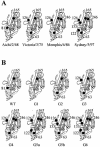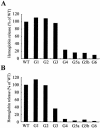Effect of the addition of oligosaccharides on the biological activities and antigenicity of influenza A/H3N2 virus hemagglutinin
- PMID: 15331693
- PMCID: PMC514993
- DOI: 10.1128/JVI.78.18.9605-9611.2004
Effect of the addition of oligosaccharides on the biological activities and antigenicity of influenza A/H3N2 virus hemagglutinin
Abstract
Influenza A/H3N2 viruses have developed an increased number of glycosylation sites on the globular head of the hemagglutinin (HA) protein since their appearance in 1968. Here, the effect of addition of oligosaccharide chains to the HA of A/H3N2 viruses on its biological activities was investigated. We constructed seven mutant HAs of A/Aichi/2/68 virus with one to six glycosylation sites on the globular head, as found in natural isolates, by site-directed mutagenesis and analyzed their intracellular transport, receptor binding, and cell fusion activities. The glycosylation sites of mutant HAs correspond to representative A/H3N2 isolates (A/Victoria/3/75, A/Memphis/6/86, or A/Sydney/5/97). The results showed that all the mutant HAs were transported to the cell surface as efficiently as wild-type HA. Although mutant HAs containing three to six glycosylation sites decreased receptor binding activity, their cell fusion activity was not affected. The reactivity of mutant HAs having four to six glycosylation sites with human sera collected in 1976 was much lower than that of wild-type HA. Thus, the addition of new oligosaccharides to the globular head of the HA of A/H3N2 viruses may have provided the virus with an ability to evade antibody pressures by changing antigenicity without an unacceptable defect in biological activity.
Copyright 2004 American Society for Microbiology
Figures






References
-
- Caton, A. J., G. G. Brownlee, J. W. Yewdell, and W. Gerhard. 1982. The antigenic structure of the influenza virus A/PR/8/34 hemagglutinin (H1 subtype). Cell 31:417-427. - PubMed
MeSH terms
Substances
LinkOut - more resources
Full Text Sources
Other Literature Sources

